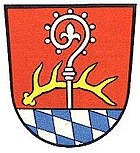Beilngries district
| coat of arms | Germany map | |
|---|---|---|

|
Coordinates: 49 ° 2 ′ N , 11 ° 28 ′ E |
|
| Basic data (as of 1972) | ||
| Existing period: | 1862-1972 | |
| State : | Bavaria | |
| Administrative region : | Upper Palatinate | |
| Administrative headquarters : | Beilngries | |
| Area : | 275.45 km 2 | |
| Residents: | 17,200 (December 31, 1971) | |
| Population density : | 62 inhabitants per km 2 | |
| License plate : | AT | |
| Circle key : | 09 3 32 | |
| Circle structure: | 45 parishes | |
| Address of the district administration: |
8432 Beilngries | |
| Location of the district of Beilngries in Bavaria | ||
The district of Beilngries belonged to the Bavarian administrative district of Upper Palatinate . Before the beginning of the Bavarian regional reform in the early 1970s, the district comprised 45 communities.
geography
Important places
The most populous places in the district were Beilngries and Berching .
Neighboring areas
In 1972 the district bordered clockwise to the north, beginning with the districts of Neumarkt in der Oberpfalz , Parsberg , Riedenburg , Eichstätt and Hilpoltstein .
history
District Office
The district office of Beilngries was formed in 1862 in the administrative district of Middle Franconia through the merger of the regional courts of the older order of Beilngries and Greding .
On the occasion of the reform of the layout of the Bavarian district offices, the Beilngries district office received municipalities from the Hemau district office on January 1, 1880 when municipalities were ceded to the new Hilpoltstein district office. At the same time, the district office changed from the Central Franconia region to the Upper Palatinate region.
The Riedenburg district office was formed in 1908 by hiving off 53 communities from the Beilngries district office.
On April 1, 1926, the communities Schnufenhofen and Wissing moved to the Parsberg district office and on October 1, 1926, the Großalfalterbach community moved to the Neumarkt district office in the Upper Palatinate.
district
On January 1, 1939, as everywhere in the German Reich, the designation district was introduced. So the district office became the district of Beilngries.
On July 1, 1972, the district of Beilngries was dissolved as part of the regional reform in Bavaria . The town of Beilngries and the municipalities of Amtmannsdorf , Aschbuch , Biberbach , Eglofsdorf , Grampersdorf , Hirschberg , Kevenhüll , Kottingwörth , Litterzhofen , Oberndorf , Paulushofen and Wiesenhofen came to the district of Eichstätt in the administrative district of Upper Bavaria . The city of Berching and all other communities came to the Upper Palatinate district of Neumarkt in the Upper Palatinate . The last district administrator was the lawyer Hans Pröll (1922–2017) since 1953 and thus for three electoral terms.
Population development
| year | Residents | source |
|---|---|---|
| 1864 | 25,354 | |
| 1885 | 28,637 | |
| 1900 | 28,465 | |
| 1910 | 14,772 | |
| 1925 | 13,966 | |
| 1939 | 13,836 | |
| 1950 | 19,534 | |
| 1960 | 16,100 | |
| 1971 | 17,200 |
Communities
Until the beginning of the Bavarian regional reform, 45 municipalities belonged to the district:
License Plate
On July 1, 1956, the district was assigned the distinctive sign BEI when the vehicle registration number that is still valid today was introduced . It was issued until August 3, 1974.
See also
- Town hall (Beilngries) , until 1972 district office Beilngries
literature
- Gerhard Hirschmann: Eichstätt. Beilngries-Eichstätt Greding (= Historical Atlas of Bavaria, part of Franconia . I, 6). Komm. Für Bayerische Landesgeschichte, Munich 1959, DNB 452034655 ( digitized version ).
Individual evidence
- ^ Official register of places for Bavaria 1964
- ^ Wilhelm Volkert (ed.): Handbook of Bavarian offices, communities and courts 1799–1980 . CH Beck, Munich 1983, ISBN 3-406-09669-7 , p. 433 .
- ^ Wilhelm Volkert (ed.): Handbook of Bavarian offices, communities and courts 1799–1980 . CH Beck, Munich 1983, ISBN 3-406-09669-7 , p. 97 .
- ^ Federal Statistical Office (ed.): Historical municipality directory for the Federal Republic of Germany. Name, border and key number changes in municipalities, counties and administrative districts from May 27, 1970 to December 31, 1982 . W. Kohlhammer, Stuttgart / Mainz 1983, ISBN 3-17-003263-1 , p. 640 .
- ↑ Eichstätter Kurier of March 21, 2017, p. 28
- ^ Eugen Hartmann: Statistics of the Kingdom of Bavaria . Ed .: Royal Bavarian Statistical Bureau. Munich 1866, population figures of the district offices 1864 ( digitized version ).
- ↑ Royal Bavarian Statistical Bureau (ed.): Localities directory of the Kingdom of Bavaria . Munich 1888, population figures of the district offices 1885 ( digitized ).
- ↑ a b www.gemeindeververzeichnis.de
- ^ Localities directory for the Free State of Bavaria, based on the census of June 16, 1925
- ↑ Statistical Yearbook for the German Reich 1940
- ↑ Statistical Yearbook for the Federal Republic of Germany 1952
- ↑ Statistical Yearbook for the Federal Republic of Germany 1961
- ↑ Statistical Yearbook for the Federal Republic of Germany 1973


